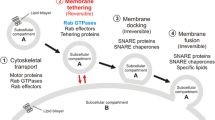Summary
Extracts of 52 TRP3 mutants of Neurospora crassa were tested for the presence of serologically cross-reacting material by the method of electrophoretic blot analysis. The test antigen was obtained by excision of lightly stained bands of denatured pure tryptophan synthase after SDS-polyacrylamide gel electrophoresis. Rabbit antisera raised against this antigen neutralized and precipitated native tryptophan synthase. Of the 52 strains, 19 exhibited banding patterns similar to wild type on electrophoretic blots, 25 strains gave no apparent bands, and 8 strains showed unique banding patterns. This evidence and related genetic fine structure mapping data indicate that strains exhibiting banding patterns similar to wild type carry missense mutations. Strains which did not exhibit any obvious bands may have resulted from certain kinds of missense or nonsense mutations or from frameshift mutations or extended deletions. Strains exhibiting unique banding patterns on electrophoretic blots were interpreted as carrying chain-terminating mutations or deletions. Genetic fine structure mapping data place the mutant lesions of these strains in a linear order corresponding to the apparent molecular weights of the crossreacting protein fragments which they exhibit. The direction of transcription and translation of the TRP3 locus in Neurospora was inferred from these relationships. The apparent organization of the Neurospora TRP3 gene is consistent with that ascribed to the Saccharomyces TRP5 system and suggests that the N-terminal portion of the protein corresponds to the “A” protein of the Escherichia coli system and that the C-terminal portion of the protein corresponds to the “B” protein of the bacterial system.
Similar content being viewed by others
References
Bonner DM, DeMoss JA, Mills SE (1965) The evolution of an enzyme. In: Bryson V, Vogel HJ (eds) Evolving genes and proteins. Academic Press, New York, pp 305–318
Crawford I, Ito J (1964) Serine deamination by the B protein of Escherichia coli tryptophan synthetase. Proc Natl Acad Sci USA 15:390–397
Creighton TE (1970) A steady state kinetic investigation of the reaction mechanism of the tryptophan synthetase of Escherichia coli. Eur J Biochem 13:1–10
DeMoss JA (1962) Studies on the mechanism of the tryptophan synthetase reaction. Biochim Biophys Acta 62:279–293
Dettwiler M, Kirschner K (1979) Tryptophan synthase from Saccharomyces cerevisiae is a dimer of two polypeptide chains of MW 76000 each. Eur J Biochem 102:159–165
Fairbanks G, Stick TL, Wallach DFH (1971) Electrophoretic analysis of the major polypeptides of the human erythrocyte membrane. Biochemistry 10:2606–2617
Kaplan S, Suyama Y, Bonner DM (1964) Fine structure analysis at the td locus of Neurospora crassa. Genetics 49:145–158
Kirschner K, Wiskocil R (1972) Enzyme-enzyme interactions in tryptophan synthetase. In: Jaenicke R, Helmreich E (eds) Colloquium der Gesellschaft für biologische Chemie. Springer, Berlin, Heidelberg, New York, pp 245–268
Lacy AM (1959) A genetic analysis of the td locus in Neurospora crassa. Ph.D. thesis. Yale University, New Haven, Conn
Lacy AM (1965) Structural and physiological relationships within the td locus in Neurospora crassa. Biochem Biophys Res Commun 18:812–823
Lacy AM, Bonner DM (1961) Complementation between alleles of the td locus in Neurospora crassa. Proc Natl Acad Sci USA 47:72–77
Manney TR (1968) Evidence for chain termination by super-suppressible mutants in yeast. Genetics 60:719–733
Matchett WH (1972) Inhibition of tryptophan synthetase by indoleacrylic acid. J Bacteriol 110:146–154
Matchett WH (1974) Indole channeling by tryptophan synthase of Neurospora. J Biol Chem 249:4041–4049
Matchett WH, DeMoss JA (1975) The subunit structure of tryptophan synthase from Neurospora crassa. J Biol Chem 250:2941–2946
Rachmeler M, Yanofsky C (1959) Biochemical and genetic studies with a new td mutant type in Neurospora crassa. Bacteriol Proc 30
Sarabhai AS, Stretton AO, Brenner S, Bolle A (1964) Colinearity of the gene with the polypeptide chain. Nature 201:13
Seale T (1968) Reversion of the am locus in Neurospora: evidence for nonsense suppression. Genetics 58:85–99
Seale TM, Case M, Barratt RW (1969) Supersuppressors in Neurospora crassa. Neurospora Newslett 15:5
Suskind SR (1957) Properties of a protein antigenically related to tryptophan synthetase in Neurospora crassa. J Bacteriol 74:308–318
Suskind SR, Yanofsky C, Bonner DM (1955) Allelic strains of Neurospora lacking tryptophan synthetase: A preliminary immunochemical characterization. Proc Natl Acad Sci USA 41:577–582
Suyama Y, Lacy AM, Bonner DM (1964) A genetic map of the td locus of Neurospora crassa. Genetics 49:135–144
Towbin H, Staehelin T, Gordon J (1979) Electrophoretic transfer of proteins from polyacrylamide gels to nitrocellulose sheets: Procedure and some applications. Proc Natl Acad Sci USA 76:4350–4354
Vogel HJ (1964) Distribution of lysine among fungi: Evolutionary implications. Am Nat 98:435–446
Weber K, Pringle JR, Osborn M (1972) Measurement of molecular weights by electrophoresis on SDS-acrylamide gel. Methods Enzymol 26:3–27
Westergaard M, Mitchell HR (1947) Neurospora V. A synthetic medium favoring sexual reproduction. Am J Bot 34:573–577
Yanofsky C (1960) The tryptophan synthetase system. Bacteriol Rev 24:221–245
Yanofsky C (1984) Comparison of regulatory and structural regions of the genes of tryptophan metabolism. Mol Biol Evol 1:142–161
Yanofsky C, Bonner DM (1955) Gene interaction in tryptophan synthetase formation. Genetics 40:761–769
Yanofsky C, Carlton BC, Guest JR, Helinski D, Hennig U (1964) On the co-linearity of gene structure and protein structure. Proc Natl Acad Sci USA 51:266–272
Yu PH, Kula MR, Tsai H (1973) Studies on the apparent instability of Neurospora tryptophan synthase. Eur J Biochem 32:129–135
Zalkin H, Yanofsky C (1982) Yeast gene TRP-5: structure, function, regulation. J Biol Chem 257(3):1491–1500
Author information
Authors and Affiliations
Additional information
Communicated by C.P. Hollenberg
Rights and permissions
About this article
Cite this article
Matchett, W.H., Lacy, A.M. & DeMoss, J.A. Orientation of enzymic domains in tryptophan synthase of Neurospora crassa: An immunoblot analysis of TRP3 mutant products. Mol Gen Genet 208, 398–407 (1987). https://doi.org/10.1007/BF00328130
Received:
Issue Date:
DOI: https://doi.org/10.1007/BF00328130




